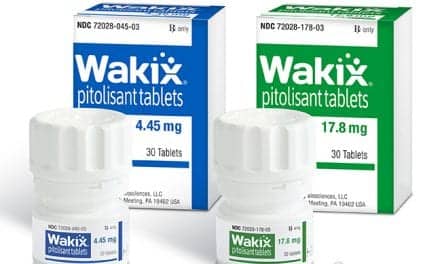At the American Neurological Association (ANA) annual meeting this week, new real-world data was presented identifying comorbidities and demographic characteristics of patients with narcolepsy. Avadel Pharmaceuticals plc provided support for the study, along with three encore presentations related to LUMRYZ, its investigational formulation of sodium oxybate designed to be taken once at bedtime for the treatment of cataplexy or excessive daytime sleepiness in adults with narcolepsy.
“These data mark the first time we are analyzing aggregate information about patients with narcolepsy receiving treatment within the Mayo Clinic system over the last 20 years. More than 2,000 patients with narcolepsy were matched to a similar cohort, where we identified the top 20 comorbidities increased in people with narcolepsy, which were primarily mood, sleep, and pain disorders,” says Melissa Lipford, MD, a neurologist at the Center for Sleep Medicine at Mayo Clinic and lead author on the abstract, in a release. “While the increased rate of mood and sleep disorders is well documented in the literature, understanding the increased prevalence of pain disorders is important, as we know that sleep and pain have a bidirectional relationship.”
The retrospective analysis was conducted in partnership with Mayo Clinic and real-world evidence vendor nFerence using electronic health records to identify people living with narcolepsy between 2000 and 2020 and describe their demographic characteristics and comorbidities. A matched control cohort was used to account for differences in demographics, care utilization, and severity of illness. Highlights from the presentation are outlined below.
Demographic Characteristics and Comorbidities of Patients With Narcolepsy: a Propensity Score-Matched Cohort Study
People living with narcolepsy experienced mood, sleep, and pain comorbidities more frequently than the matched cohort; restless leg syndrome was reported nearly four times more often (OR: 3.94); obstructive sleep apnea more than three times as often (OR: 3.27), and insomnia was nearly doubled (OR: 1.84).
For mood comorbidities, depression, anxiety, and dysthymia were all increased (OR: 2.11, 1.86 and 1.67, respectively).
Various pain disorders were also increased: chronic pain syndrome (OR: 2.20); migraine (OR: 1.96), fibromyalgia (OR: 1.90), carpal tunnel syndrome (OR: 1.80), and myalgia (OR: 1.69) All were significantly increased (p<.001) in the narcolepsy cohort compared to the matched cohort.
Among the remaining top 20 increased comorbidities, irritable bowel syndrome, asthma, cervical spondylosis, syncope, and hypothyroidism were significantly (p<0.005) increased in the narcolepsy cohort.
Overall, demographics were well balanced between cohorts (n=2,057 in each group); participants were predominantly female, white, and non-Hispanic. The propensity-matched control cohort was created after propensity matching for birth year, age at first encounter at the institution, sex, race, ethnicity, number of diagnosis codes, and mortality to account for differences in demographics, care utilization, and severity of illness.
“Partnering with Mayo Clinic and nFerence and utilizing electronic health record data provides us insight into the increased comorbidities in people living with narcolepsy,” says Jennifer Gudeman, PharmD, vice president, medical affairs of Avadel, in a release. “It has been well established in the literature that people with narcolepsy have increased rates of comorbid mood and sleep disorders; these are the first data identifying various pain disorders that are also increased in people with narcolepsy compared to a matched cohort. With the exception of long QT syndrome, no other cardiovascular disorders were among the top 20 conditions found to be increased in the narcolepsy cohort.
“We were also pleased to present additional data on LUMRYZ, which further validates the transformative place in therapy this once-at-bedtime sodium oxybate drug candidate will have, when we receive final FDA approval.”
Avadel is also presenting encore posters at the annual meeting featuring:
- Results from a discrete choice experiment confirming that once-nightly dosing, when compared to twice-nightly dosing, was the most important attribute driving both patient and clinician preference for overall oxybate product choice, as well as patient quality of life and reduction of patient anxiety/stress. The dosing regimen was identified by both patients and clinicians as a more significant driver of choice than the sodium content in these formulations.
- Post hoc analyses from the completed pivotal Phase 3 REST-ON trial of LUMRYZ (also known as FT218) demonstrating positive results that are generally consistent with previously reported positive endpoints from REST-ON and add to the existing body of evidence for LUMRYZ.
Avadel also recently presented encore posters featuring interim analyses from the ongoing RESTORE open-label extension/switch study of LUMRYZ at the American College of Chest Physicians (CHEST) annual meeting which took place October 16-19, 2022, including:
- Updated safety data affirming that LUMRYZ has been generally well tolerated with low discontinuation rates and no new safety signals.
- Updated data related to dosing and titration demonstrating that most RESTORE participants, whether switching from immediate release oxybate or not currently taking oxybate, have successfully had their LUMRYZ dose titrated to a tolerable therapeutic dose.
- Updated results from patient preference and nocturnal adverse event questionnaires from the RESTORE study with 93.6% of patients who switched from twice-nightly oxybates stating prefer for the once-at-bedtime dosing regime, as well as confirming challenges related to the middle-of-the-night dose.
Illustration 24093296 © Artistashmita | Dreamstime.com




